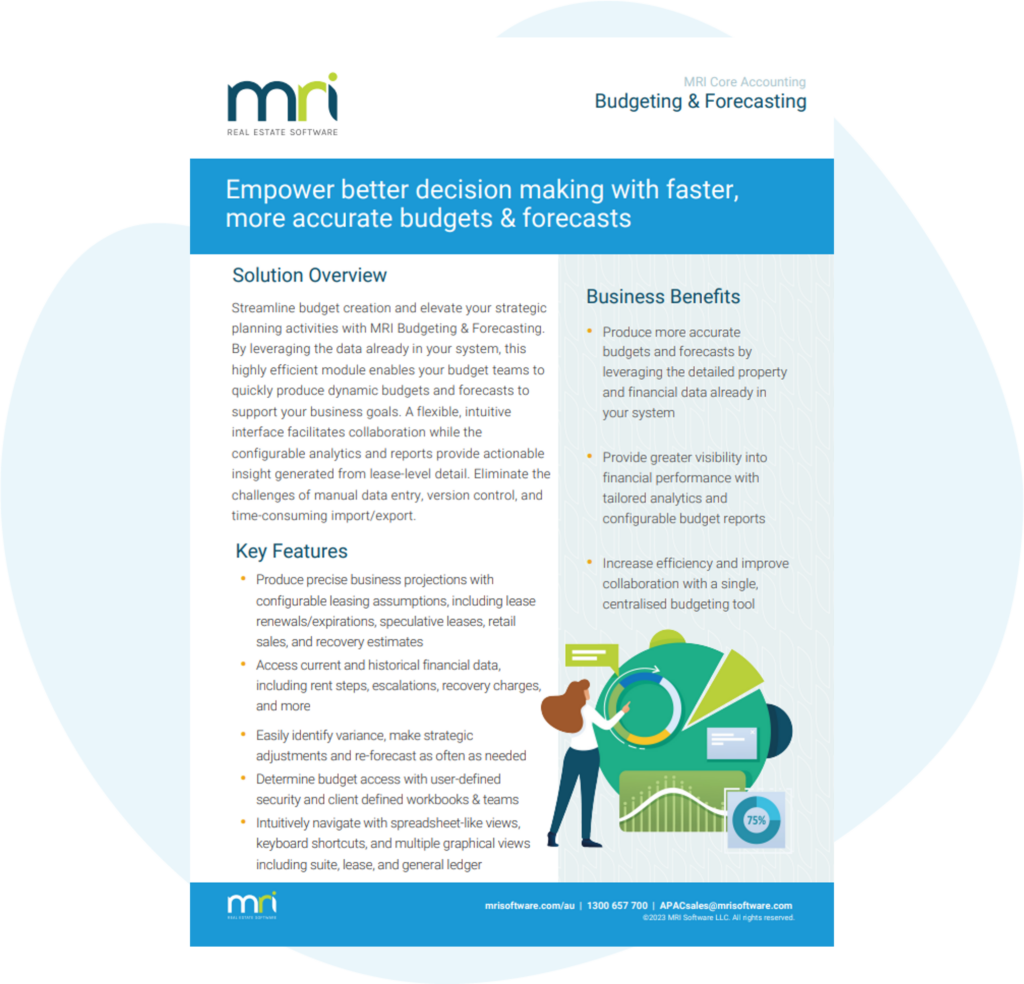Three ways to master the complexities of data in real estate financial reporting
This blog was written by insightsoftware, a global provider of enterprise software solutions for the Office of the CFO to connect to and make sense of their data in real time so they can proactively drive greater financial intelligence across their organisation. Learn more about MRI’s integration with insightsoftware here.
If you are a finance manager in real estate and property management, you likely face more than just reporting challenges. In addition to the typical period finance reports such as income statements, balance sheets, P&L, etc., you may also be responsible for keeping track of renter and vendor status and terms, staying on top of changing trends in the market for analysis and projections, and being cognisant of numerous changes in regulations and legislation that affect the business.
How can you keep track of all of this while continuing to maintain timely period financial reporting? It’s a story about data: how to find what you need, capture it, and then put it into a presentable form under deadlines that make or break your ability to help your company succeed.
The challenges of data in real estate
Financial teams don’t just run the standard financial statements; they also run several specific reports based on their company’s role in real estate. In property management, finance can be responsible for running rent roll reports that require certain data such as unit information, lease dates, market rent, recurring charge amounts, recurring credit amounts, a sum of all deposits held, and the balance due. In a property investment firm, finance may be running specific reports that keep track of data such as investment property value (and property under development), joint ventures, deferred tax assets, inventory property, contract cost assets, prepayments, and short-term deposits.
Keeping track of all this data comes down to finding it and making it usable. In many cases, you need data from multiple systems, such as from your MRI property management system. But then you may need to merge that data with billing or credit data from your CRM, or asset maintenance costs from your ERP.
And then, once you have all that data, you need to be able to drill into it to solve issues and variances.
Data issues that keep real estate financial teams up at night
- Managing the effect of changing interest rates that impact costs of housing and the ability of consumers to buy or rent
- Profitability
- Efficiently managing properties, sales, leases
- State and local legislation and regulation
What to consider in real estate financial reporting
With changing conditions in vacancies, popularity of urban sites, and renter buying power, real estate and property management companies need to stay on top of how to capture the data they need for on-demand decision-making, how to reduce delays in reporting processes, and how to quickly resolve any discrepancies they uncover through reporting or analytics.
Support changing regulations with the right data
Real estate agencies must ensure that policies, processes, controls, and systems are in place to capture all the changes that can occur across their global portfolios. They need to ensure that their data is complete and up to date, and supports accurate accounting required for ongoing, sustainable compliance.
As an example: Moving to the new lease standard has an enormous effect on what data needs to be captured from systems and reported on, as well as how it’s reported. New requirements call for finance teams to:
- Identify and account for additional assets such as office space floors, storage space, signage, and land, and then manage and account for changes to the assets over the entire lease cycle
- Allocate and separate lease components (the right to use the property) and non-lease components (transfer of goods or services unrelated to using the property), which affects balance sheets
- Capture reassessments, modification, and remeasurements
Eliminate the bottlenecks in reporting
If you use one of the standard property management systems to manage rent and property transactions, you know that capturing and formatting it consumes an extremely large part of your day. And you have rework and rerun your reports every time your data changes.
Considering the huge number of reports you need to maintain, the amount of time spent on this essential reporting starts to add up. Do you find that you have to either outsource some of the work to expensive consultants, or just put off those reports that aren’t necessary right away and run the risk of not having them when you need them?
And what about report design? Are you spending time creating your own formats, which then have to change when your organisation acquires a new property, or switches REITs, or merges with another company?
Find the “needle in the haystack” – quick answers to any errors
After creating your reports, you may discover an error. Now you have to go back and find where that data came from. In which system did it originate? Which data dump had the source noted on it? After some time, you finally discover the source of the data, but now you have to go back and rework your reports and rerun them. Imagine if this happened more than a couple of times over multiple areas such as invoice numbers, rents, leases, cash payments, maintenance, insurance, and filings. You could be spending days drilling into sub-ledger data to find and reconcile issues.
The right approach to accelerating insights and reporting
Using the appropriate tool for the job is an approach we take for granted, but in the case of financial reporting for real estate, it can make a tremendous difference. If you had a reporting tool that enabled you to find all that data you needed almost instantly and delivered it to you without requiring searching through multiple systems, you would save hours of time and stress. Consolidating data across multiple properties or investments means the reporting tool would have understood your specific real estate and property management terms and how the data was stored in various systems.
What if the reporting tool already knew the majority of the report layouts you needed, or was built for quick ad hoc report creation without relying upon a power user or an IT consultant? And if the data in that report could be refreshed at any time, without requiring any rework of formatting changes? If you are spreadsheet user, what could be better than a reporting tool that provided the data you needed inside a tool you already use?
Don’t struggle with your data and reporting anymore. With the help of insightsoftware reporting and analytics solutions for real estate and property management, you can simplify and accelerate your reporting, master any data complexities, and meet your deadlines on time.
Learn more about current market insights for the real estate and property management market and how technology can afford opportunities to integrate and automate real-time reporting capabilities for your finance team by downloading our whitepaper, Real Estate and Property Management: 2020 Industry Outlook for F&A Professionals.
To find out more, request a demo with one of our real estate and property management reporting experts today.
Property Management Software
Multi-discipline technology for property owners, investors and occupiers.

Empower better decision-making with faster, more accurate budgets & forecasts
Unlock the potential of your financial data with our MRI Budgeting & Forecasting solution. Our comprehensive tool offers a streamlined approach to creating budgets, allowing you to generate dynamic budgets and forecasts efficiently. Eliminate the…
